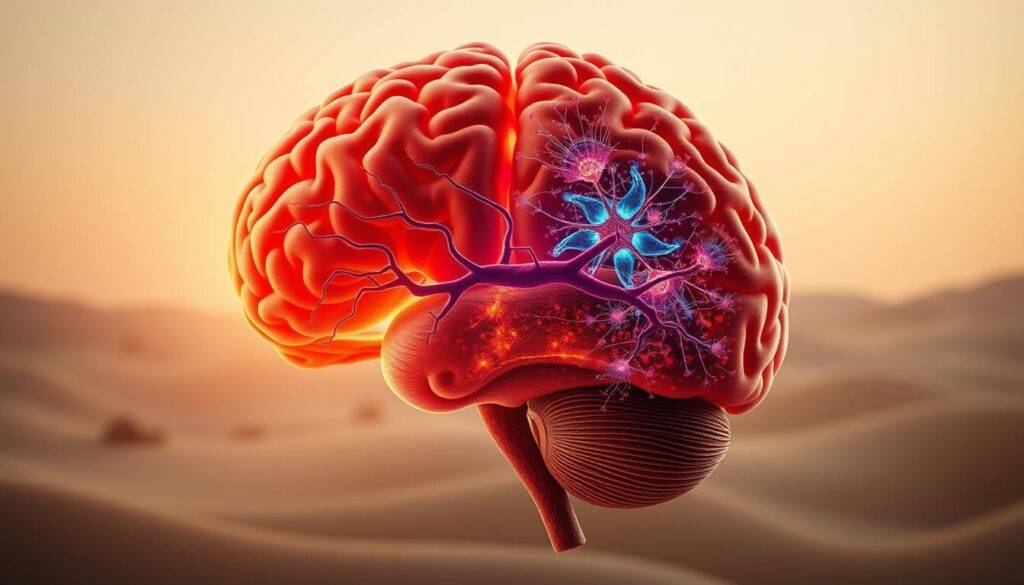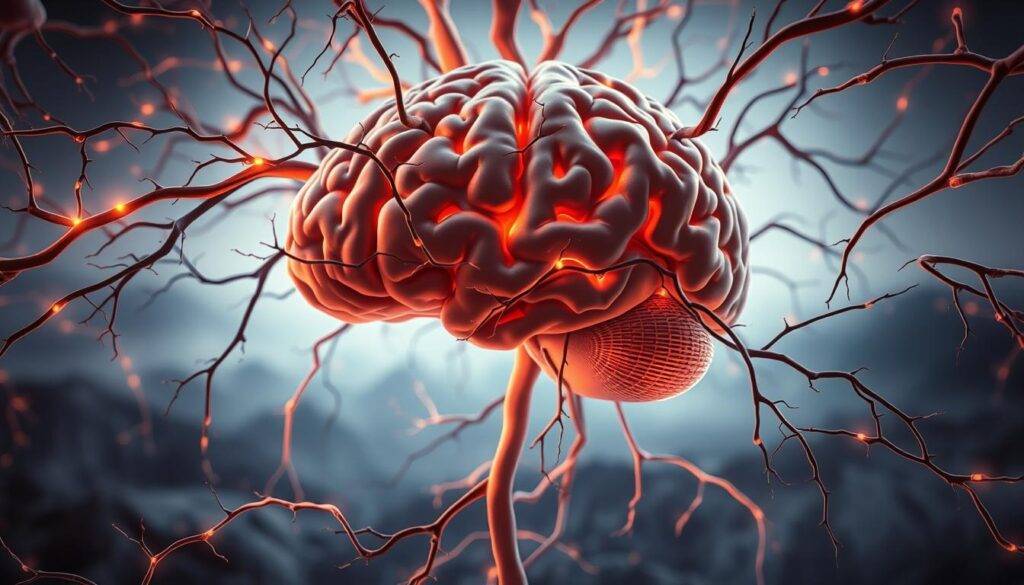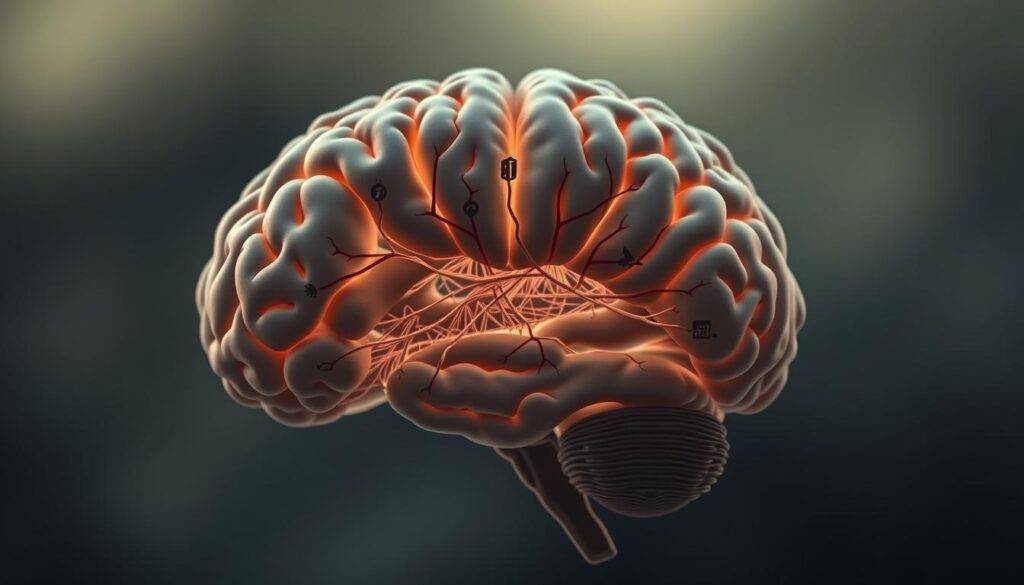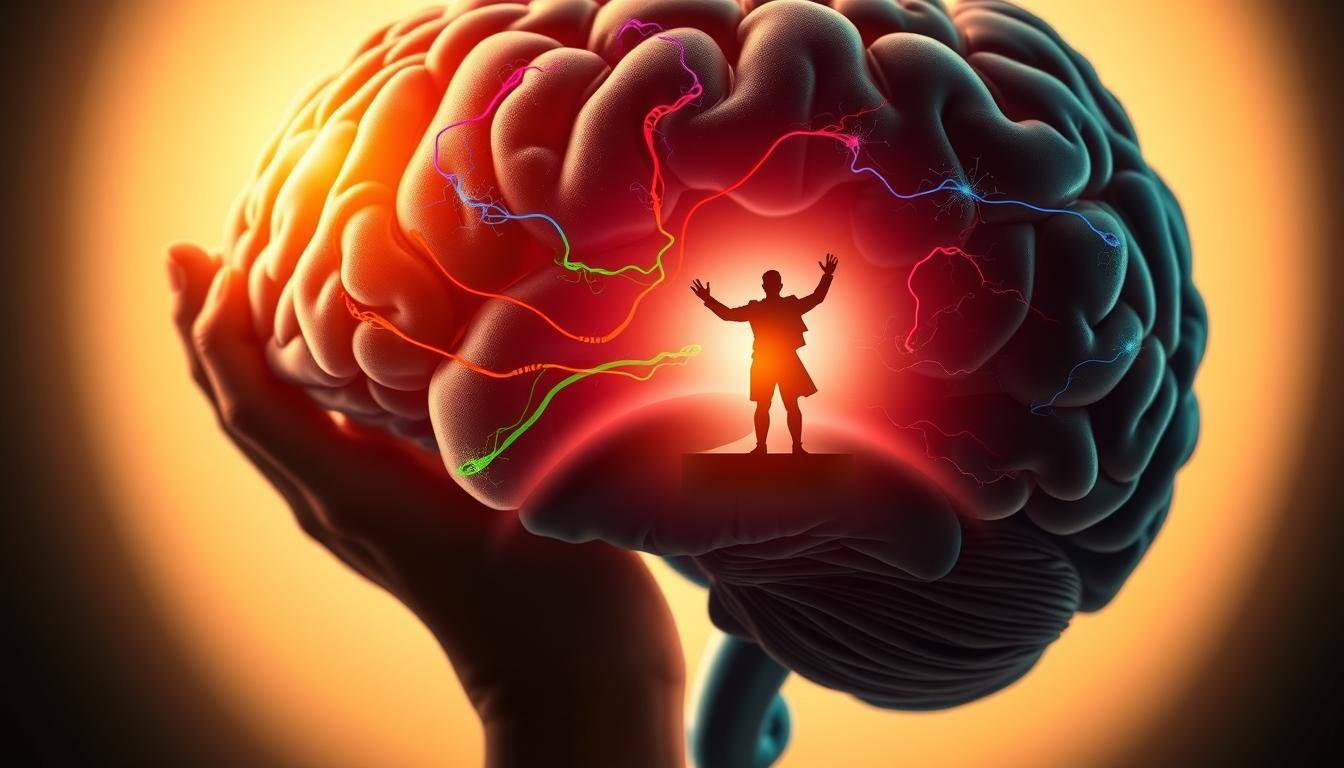“We are what we repeatedly do. Excellence, then, is not an act, but a habit.” – Aristotle’s timeless words remind us that behavior shapes identity. But what if you could redesign those patterns using your brain’s natural adaptability?
Every habit you’ve developed exists as a neural pathway in your brain. Through self-directed neuroplasticity – the brain’s ability to rewire itself – you can transform automatic routines into intentional actions. Pioneers like Dr. Jeffrey Schwartz and Dr. Rick Hanson have shown that focused repetition strengthens new connections while weakening outdated ones.
This process isn’t about willpower. It’s about understanding how rewards, triggers, and repetition shape behavior. When you align actions with your brain’s learning mechanisms, lasting change becomes systematic rather than stressful.
Imagine replacing frustration with clarity. This guide reveals science-backed strategies to reshape your daily patterns. You’ll discover how to leverage neuroplasticity, design effective rewards, and build momentum through incremental progress.
Key Takeaways
- Your brain physically changes through repeated thoughts and actions
- Self-directed neuroplasticity puts habit transformation in your control
- Habits form through consistent trigger-action-reward cycles
- Neuroscience experts provide proven frameworks for sustainable change
- Small, strategic adjustments create compounding results over time
The Science Behind Habit Formation
The human brain operates like a sophisticated habit-forming machine, sculpting neural pathways with every repeated action. MIT research reveals that habits account for nearly 45% of daily behaviors – automatic patterns stored in the basal ganglia. This ancient brain region collaborates with the prefrontal cortex, which handles conscious decision-making, creating a biological partnership that shapes routines.

Understanding Neuroplasticity and Self-Directed Change
Neuroplasticity – the brain’s ability to rewire itself – transforms temporary actions into lasting patterns. When you repeat a cue-triggered behavior, dopamine release strengthens specific neural connections. Over time, the basal ganglia takes control, making actions automatic. This explains why 81% of New Year’s resolutions fail: unconscious patterns often override conscious goals.
The Habit Loop: Cue, Action, and Reward Explained
Every habit follows a three-part loop:
- Cue: A trigger like stress or a specific location
- Action: The routine itself (e.g., reaching for snacks)
- Reward: Dopamine-driven satisfaction that cements the pattern
Consider the “doughnut incident” study: participants automatically craved sweets when passing a bakery, demonstrating how environmental cues drive behaviors. By consciously redesigning these loops, you can reprogram responses while leveraging your brain’s natural learning systems.
how to create new habits with neuroscience-based methods
Neuroscience reveals that intentional behavior transformation requires aligning actions with your brain’s natural learning mechanisms. Research shows deliberate control over your environment and energy levels accelerates this process – it’s not about willpower, but strategic design.

Start by identifying existing routines where new patterns can attach. A 2023 UC Davis study found that pairing novel actions with established triggers (like morning coffee) increases success rates by 63%. This system of “habit stacking” leverages existing neural pathways, reducing cognitive load.
| Time of Day | Energy Phase | Ideal Habit Type |
|---|---|---|
| 6-9 AM | Peak focus | Complex tasks |
| 12-3 PM | Post-lunch dip | Physical movement |
| 5-8 PM | Creative surge | Skill practice |
Optimize your physical space to support desired behaviors. Remove visual clutter – MIT neuroscientists confirm distraction-free zones improve follow-through by 41%. Use deliberate practice principles: break actions into micro-steps with immediate rewards.
Track progress in 3-day cycles rather than weeks. This matches the brain’s natural consolidation rhythm. “Consistency beats intensity every time,” notes Stanford behavior expert Dr. Emily Balcetis. Pair this with nightly reflection to strengthen neural connections through targeted reinforcement.
Step-by-Step Techniques for Rewiring Your Brain
Practical neuroscience strategies turn abstract concepts into lasting behavior shifts. By combining deliberate reflection with pattern replacement, you can systematically upgrade your neural architecture. Start by identifying one routine where old patterns clash with desired outcomes.

Reflecting on Behavior and Creating Positive Associations
Immediate self-observation accelerates habit formation. Keep a pocket journal to record actions during or right after routines. Note triggers like specific locations or emotional states. A 2022 UCLA study found participants who journaled for 90 seconds post-activity improved pattern recognition by 57%.
Pair new behaviors with sensory rewards. If replacing afternoon snacking with a walk, listen to an engaging podcast. This creates dopamine-linked associations – the brain’s natural reinforcement system.
Swapping Old Habits for New Neural Patterns
Disrupt the habit loop by inserting a 10-second pause between trigger and action. During this window, consciously choose an alternative response. For example: When reaching for your phone (cue), practice deep breathing (new action) before checking messages.
Research from Johns Hopkins reveals this “pattern interruption” weakens existing neural pathways while strengthening replacements. Start with low-stakes scenarios – like changing your coffee preparation routine – to build confidence in your rewiring capacity.
Successful habit formation relies on consistency, not perfection. Track three-day streaks using a simple calendar. Each checkmark physically demonstrates progress, activating the brain’s reward centers through visible achievement.
Practical Strategies for Breaking Unwanted Habits
Breaking entrenched patterns requires strategic insight into your brain’s wiring. Environmental triggers and neural feedback loops often sustain bad habits, but targeted interventions can reshape these pathways. Neuroscience reveals that combining awareness with deliberate action creates lasting shifts.

Mapping Your Habit Landscape
Start by tracking triggers for one week. Note locations, times, and emotional states preceding unwanted actions. A 2024 cognitive neuroscience research study found 78% of participants identified previously unnoticed cues through this method.
| Common Trigger | Replacement Action | Prefrontal Cortex Engagement |
|---|---|---|
| Afternoon energy slump | 5-minute walk outside | Activates decision-making regions |
| Phone notifications | Deep breathing exercise | Strengthens impulse control |
| Evening boredom | Guitar practice | Builds skill-related neural networks |
Rewiring Through Replacement
When cravings strike, initiate a 90-second alternative behavior. Ten jumping jacks or brisk stair climbing provides immediate physical feedback. This disrupts automatic patterns while giving the prefrontal cortex time to override impulsive responses.
Mindfulness as a Neural Reset
Daily 3-minute meditation sessions strengthen gray matter in self-regulation areas. Focus on breath during stressful moments – this simple act reduces amygdala activation by 31%, according to UCLA brain imaging studies. Pair mindfulness with routine adjustments for compounded effects.
Consistency matters more than perfection. Track three-day blocks of successful pattern interruption. Over six weeks, these micro-wins rewire the basal ganglia’s automatic responses, proving that formation of healthier behaviors stems from strategic repetition.
Harnessing Daily Rhythms and Habit Stacking

Your body’s internal clock holds untapped potential for sustainable behavior change. Neuroscience reveals that aligning actions with natural energy fluctuations reduces friction and amplifies results. The day divides into three neurochemical phases, each offering unique opportunities for growth.
Leveraging the Huberman Lab Phases
Research divides the 24-hour cycle into distinct windows:
- 0-8 hours (Morning): High dopamine and cortisol prime focus for complex work
- 9-15 hours (Midday): Serotonin rise supports social interactions and physical actions
- 16-24 hours (Evening): Melatonin preparation enhances reflection and creative tasks
Optimize challenging tasks before noon when willpower peaks. Save routine activities for afternoon energy dips. This strategic alignment helps conserve mental resources while achieving goals.
Building Neural Networks Through Stacking
Habit stacking anchors new behaviors to existing routines, creating neural bridges. After brushing teeth (established habit), immediately journal for two minutes (new practice). This method leverages the brain’s pattern recognition power.
Reduce friction by:
- Pairing habits requiring similar tools
- Using visual cues in trigger locations
- Celebrating micro-wins with sensory rewards
Dr. Andrew Huberman suggests starting with “phase-matched” strategies. Morning might include cold exposure to boost adrenaline, while evenings could feature gratitude practices to reinforce positive neural pathways. These strategies transform daily rhythms into engines for lasting transformation.
Implementing a 21-Day Habit Transformation Program
Consistent behavior change thrives on structured systems. Neuroscience research from Huberman Lab reveals alternating 7-day tracking and testing phases creates lasting neural pathways. This rhythm helps the brain adapt to changes while building self-awareness.
![]()
Designing Your Progress Blueprint
Start by mapping daily cues and responses in a dedicated journal or app. Record three key details:
- Trigger locations or emotional states
- Chosen actions
- Immediate outcomes
| Phase | Days | Focus | Tools |
|---|---|---|---|
| Tracking | 1-7 | Identify patterns | Digital journal |
| Testing | 8-14 | Adjust responses | Calendar alerts |
| Optimizing | 15-21 | Strengthen pathways | Reflection prompts |
Use color-coded calendars to visualize progress. Green marks successful pattern shifts, red indicates setbacks. This visual feedback taps into the brain’s reward ability, reinforcing motivation.
Weekly review sessions help refine your approach. Compare Day 3 and Day 18 entries to spot improved responses to common cues. Neuroscience shows this reflection strengthens prefrontal cortex engagement by 29%.
Anticipate obstacles by creating “if-then” plans. Example: “If I crave sweets after stress, I’ll drink herbal tea instead.” These pre-planned pathways reduce decision fatigue during challenging moments.
Conclusion
Transforming behaviors isn’t mystical—it’s biological. Your brain’s neuroplasticity turns deliberate actions into automatic routines through repetition and dopamine-fueled rewards. This scientific truth empowers lasting change, proving you’re not stuck with inherited patterns.
Successful behavior shifts hinge on two factors: understanding your neural wiring and strategically engaging its learning systems. Immediate pleasure from small wins—like completing a three-day streak—builds momentum. These micro-outcomes strengthen new pathways while weakening outdated ones.
Remember, progress compounds. A single adjusted response to stress or boredom reshapes entire neural networks over time. Neuroscience confirms that consistency—not perfection—drives transformation. Pairing sensory rewards with intentional actions accelerates results, making growth feel natural rather than forced.
Your journey starts now. Commit to the 21-day challenge outlined earlier, using daily reflection to lock in learning. Track how dopamine-rich moments reinforce desired behaviors. Witness firsthand how aligning with your brain’s design leads to profound personal outcomes.
The power to rewire your life lives within your choices today. Embrace this science-backed path—your future self will thank you.
FAQ
Why do old habits feel harder to change than new ones?
Established habits create strong neural pathways in the brain through repetition. The basal ganglia – a brain region governing automatic behaviors – reinforces these patterns, making them energy-efficient but resistant to change. Neuroscience shows that overriding them requires conscious engagement of the prefrontal cortex to build competing neural networks.
How does dopamine influence habit formation?
Dopamine acts as a neurological reward signal, strengthening connections between cues, actions, and outcomes. Anticipating rewards – even small ones like checkmarks on a habit tracker – boosts this neurotransmitter’s release. Modern research emphasizes leveraging dopamine through immediate micro-rewards rather than waiting for distant outcomes.
Can environment design really override willpower?
Yes. The brain’s habit system responds strongly to contextual cues. Studies show reducing friction for desired behaviors (like placing workout clothes bedside) and increasing friction for unwanted actions (deleting social media apps) can shift habits with 40% less cognitive effort compared to relying solely on self-control.
Why do most habit apps fail after 2 weeks?
Many tools focus only on tracking without addressing the neuroscience of the habit loop. Effective systems combine cue redesign (environment), action simplification (behavior), and reward recalibration (dopamine management). The Huberman Lab’s phase-based approach aligns habits with natural energy cycles for better adherence.
How does habit stacking improve success rates?
Linking new routines to existing ones (like meditating after brushing teeth) leverages the brain’s pattern-completion bias. This method uses established neural pathways as scaffolding, requiring 30% less mental effort according to behavioral studies. It transforms isolated actions into automatic sequences through contextual association.
What role does sleep play in habit formation?
During sleep, the brain replays and consolidates skill memories through hippocampal-neocortical dialogue. Research from MIT’s McGovern Institute shows that consistent sleep cycles improve habit automation by 22%, as slow-wave sleep strengthens the neural connections formed during daytime repetitions.




























































